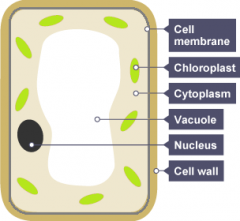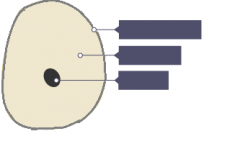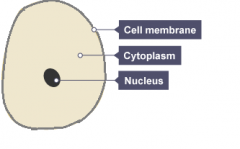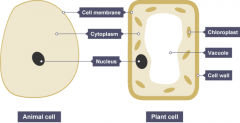![]()
![]()
![]()
Use LEFT and RIGHT arrow keys to navigate between flashcards;
Use UP and DOWN arrow keys to flip the card;
H to show hint;
A reads text to speech;
18 Cards in this Set
- Front
- Back
|
What are the seven characteristics of living organisms? Hint - MRS GREN |
Living organisms have 7 things that they need to be able to do to count as being 'alive'. Movement - all living things move Respiration - turning food into energy Sensitivity - reacting to environment Growth - all living things grow Reproduction - making more of the same kind Excretion - getting rid of waste Nutrition - taking in and using food |
|

Is this a plant or animal cell? Name the 6 key parts of the cell. |

PLANT CELL A plant cell has 6 key parts |
|

Is this a plant or animal cell? Name the 3 key parts of the cell. |

ANIMAL CELL An animal cell has three key parts |
|
|
Which parts do animal and plant cells have in common? |

They both have in common: cytoplasm nucleus |
|
|
What is the difference between the function of a cell membrane and a cell wall? |
A cell membrane controls the movement of substances in and out of the cell. A cell wall provides shape and support (it is made from a tough substance called cellulose). |
|
|
What is the function of the nucleus? |
The nucleus carries genetic information and controls what happens inside the cell. |
|
|
What is the function of the cytoplasm? |
The cytoplasm is the place where chemical reactions happen. |
|
|
What is the function of the vacuole? |
The vacuole contains a liquid (called cell sap) which helps keep the cell firm. |
|
|
What do chloroplasts contain and what happens here? |
Chloroplasts contain chlorophyll (a green pigment) and it is here that photosynthesis takes place. |
|
|
Name some specialised animal cells. How does their structure help with their job? |
Red blood cells - large surface area to carry oxygen. Nerve cells - can carry electrical signals all over the body. Female reproductive cells (egg) - large and contain lots of cytoplasm to provide food for new fertilised cell. Male reproductive cell (sperm) - Long tail for swimming in order to reach the femal egg. |
|
|
Name some specialised plant cells. How does their structure help with their job? |
Root hair cell - large surface area to absorb water and minerals. Leaf cell - large surface area and contain lots of chloroplasts to absorb sunlight for photosynthesis. |
|
|
What is a cell? |
Cells are the basic building blocks of all animals and plants |
|
|
What is living tissue?
Give an example of a tissue. |
Living tissues - made from a group of cells with a similar structure and function. They all work together to do a certain job. Example: muscle |
|
|
What is an organ? Give an example of an organ and what it does. |
An organ is made from a group of different tissues. They work together to do a particular job. Examples: heart, lung, stomach, brain |
|
|
Name the 5 organ systems of the human body. |
Circulatory Respiratory Reproductive Nervous Digestive |
|
|
What is an organ system? |
An organ system is made from a group of different organs that work together to do a job. |
|
|
Which organ system does the heart belong too? |
Circulatory |
|
|
Which organ system does the stomach belong too? |
Digestive
|

